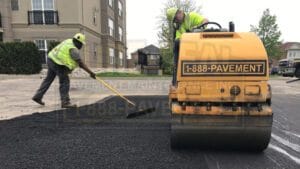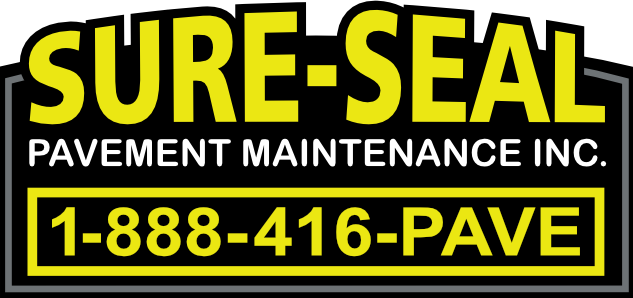
No matter how well you take care of your asphalt pavement, eventually it’s going to require a few repairs, especially if it gets a lot of usage on a daily basis. Over time, you’ll start to notice the effects of natural wear and tear. To prevent minor damages from getting worse, you need to maintain your asphalt pavement. An important part of maintenance is inspecting your pavement for small damages such as signs of cracking, dips, ravelling (when asphalt starts to disintegrate or break apart), etc.
The type of asphalt repair method you need depends on the type and extent of the damages your asphalt pavement has sustained. Just keep in mind that the longer you go without repairing damaged asphalt, the worse the damages are going to get. Extensive damages are also a lot more costly as they typically require more complex repair methods such as removal, replacement, or resurfacing. As a general rule of thumb, you should be inspecting your asphalt pavement for damages at least once a week or on a monthly basis depending on how much usage it gets. Traffic-heavy parking lots will obviously require more maintenance than those that aren’t as busy.
Common Methods for Repairing Damaged Asphalt
The hardest part of repairing asphalt is determining exactly what type of repair method you need. From there, you need to get the right materials and equipment for the job to ensure optimal and long-lasting results. Some repairs are more expensive than others, but the biggest waste of money is having to redo or fix a botched asphalt repair job. With that in mind, here are some of the most common asphalt repair methods.
Asphalt Patching
Asphalt patching, also known as surface patching, is a simple and affordable but temporary solution to fixing minor asphalt problems. If you’re strapped for time or cash at the moment and just need to quickly patch up a hole or crack to prevent it from getting worse or restore the aesthetic look of your pavement, then surface patching will get the job done.
Surface patching is only recommended for damages that go about one to two inches deep. Also, it’s important to keep in mind that it’s only a temporary solution. On average, surface asphalt patching only lasts about two years (depending on frequency of use, weather conditions, etc.) and should be checked on regularly. Eventually, you will need to opt for a more permanent and slightly more expensive repair method.
Asphalt Removal and Replacement
Also known as peel and pave, asphalt removal and replacement is a far more comprehensive and long-term solution than surface patching. This method is highly effective in preventing and repairing reflective cracking. Reflective cracking is damage that’s caused due to repeated stress concentration in a specific portion of the asphalt (e.g. heavy vehicles constantly driving over the same spot). Over time, the continuous pressure from the weight of heavy vehicles driving over the same spot will cause the overlay to crack.
Asphalt removal and replacement involves removing several layers of asphalt until the damaged portions are completely extracted. Contractors try to save as much of the original asphalt pavement as possible so that it can be mixed into a newer, stronger aggregate. That aggregate is then used to replace the old damaged asphalt. Although this process costs more and is more labour-intensive than patching, it also significantly extends the lifespan of your asphalt and means fewer future repairs.
Asphalt Milling and Resurfacing
Asphalt milling and resurfacing is an ideal solution for asphalt with large areas of distress and failure. If you need to repair a large portion of your asphalt pavement or even if you need to resurface the entire parking lot, then this method is most likely your best option.
During this process, contractors will remove all of the asphalt and grind it up into fine gravel-like pieces, so that it can be used to create a brand-new stronger aggregate. Asphalt that can’t be used to repair your property will be taken back to a processing plant and recycled for other purposes such as making construction materials. This is how the asphalt industry is able to remain sustainable and maintain a small carbon footprint.
The asphalt that’s used to create a new aggregate for your property will be used in the resurfacing or repaving process. Once this is done, you’ll be left with a beautiful, smooth, sturdy, and clean blacktop that will last for many years with proper care.
Full-Depth Repair
Full-depth asphalt repair entails replacing your entire pavement system. This method is typically reserved for situations where the damages are so extensive that they go deep beneath the surface of the asphalt pavement. Concentrated asphalt damages such as cracking, pavement failure, and severe distress can cause multiple issues such as massive potholes and crumbling across the property.
In these cases, the damages are so extensive that they go all the way down to the foundation of the pavement—the stone base. Once this becomes damaged, it’s almost impossible to repair while it’s still in the ground. Essentially, the whole foundation needs to be dug up, reformulated with a stronger aggregate, and then reapplied before replacing the asphalt aggregate on top of it. Full-depth repair basically reinforces a weakened asphalt stone base to ensure stronger structural integrity that will last for many years to come.
Asphalt Crack Filling
Small cracks on the surface of your asphalt may seem perfectly harmless at first, but they’re actually a symptom of a much deeper problem. Oftentimes, cracks in the surface of your asphalt stem from deeper cracks that are invisible because they start below the surface. These are a result of prolonged asphalt distress due to constant vehicular and even foot traffic. If you notice cracks popping up throughout your asphalt, then don’t take it lightly. You should investigate the issue to find out what’s causing them. In the meantime, cracks need to be repaired before they develop into their less-desirable counterparts, potholes. Neglected cracks will eventually become large potholes, which cause more structural damages in the long run.
Is your asphalt pavement in disrepair? Looking for cost-effective long-lasting solutions?
Sure-Seal Pavement Maintenance Inc. is one of the leading asphalt pavement contractors in Toronto and the GTA. With over 25 years of experience in the asphalt industry, we stand by our work.
Contact us today to book a consultation.
 No matter how well you take care of your asphalt pavement, eventually it’s going to require a few repairs, especially if it gets a lot of usage on a daily basis. Over time, you’ll start to notice the effects of natural wear and tear. To prevent minor damages from getting worse, you need to maintain your asphalt pavement. An important part of maintenance is inspecting your pavement for small damages such as signs of cracking, dips, ravelling (when asphalt starts to disintegrate or break apart), etc.
The type of asphalt repair method you need depends on the type and extent of the damages your asphalt pavement has sustained. Just keep in mind that the longer you go without repairing damaged asphalt, the worse the damages are going to get. Extensive damages are also a lot more costly as they typically require more complex repair methods such as removal, replacement, or resurfacing. As a general rule of thumb, you should be inspecting your asphalt pavement for damages at least once a week or on a monthly basis depending on how much usage it gets. Traffic-heavy parking lots will obviously require more maintenance than those that aren’t as busy.
No matter how well you take care of your asphalt pavement, eventually it’s going to require a few repairs, especially if it gets a lot of usage on a daily basis. Over time, you’ll start to notice the effects of natural wear and tear. To prevent minor damages from getting worse, you need to maintain your asphalt pavement. An important part of maintenance is inspecting your pavement for small damages such as signs of cracking, dips, ravelling (when asphalt starts to disintegrate or break apart), etc.
The type of asphalt repair method you need depends on the type and extent of the damages your asphalt pavement has sustained. Just keep in mind that the longer you go without repairing damaged asphalt, the worse the damages are going to get. Extensive damages are also a lot more costly as they typically require more complex repair methods such as removal, replacement, or resurfacing. As a general rule of thumb, you should be inspecting your asphalt pavement for damages at least once a week or on a monthly basis depending on how much usage it gets. Traffic-heavy parking lots will obviously require more maintenance than those that aren’t as busy.

